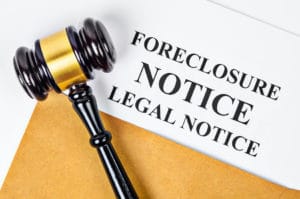 Foreclosures can occur fast, as most proceedings begin within 120 days of missed payments. In order to stop a foreclosure, the homeowner must take immediate action by contacting their lender. By starting this discussion at the first sign of a missed payment, it is possible for homeowners to create a plan of action to keep payments current. To help homeowners protect their own assets, the following information explores the top ways to stop foreclosures.
Foreclosures can occur fast, as most proceedings begin within 120 days of missed payments. In order to stop a foreclosure, the homeowner must take immediate action by contacting their lender. By starting this discussion at the first sign of a missed payment, it is possible for homeowners to create a plan of action to keep payments current. To help homeowners protect their own assets, the following information explores the top ways to stop foreclosures.
For informational purposes only. Always consult with an attorney, tax, or financial advisor before proceeding with any real estate transaction.
Foreclosure Do’s and Don’ts
Facing a foreclosure is a stressful time for any homeowner, which is why it is important for them to stay focused and do what is in their control to best help the situation. Understanding the foreclosure process can assist homeowners in making the right decisions and avoiding mistakes.
Do’s
The most important thing for a homeowner to do when facing foreclosure is to call their lender or servicer, as avoiding this step is a critical mistake that can lead to serious repercussions in the near future. It is in the lender’s best interest to help their clients retain their homes and stay current on payments, and lenders have many excellent programs available to assist.
After making the call, homeowners should contact a HUD-approved housing counselor for additional support. These professionals will take a close look at the homeowner’s financial situation and loan details to identify key solutions, including:
- Loan modification
- Refinance
- Short sale
- Deed in lieu of foreclosure
Through all discussions with both the lender and HUD counselor, homeowners should document all the information provided as well as the date, time, and person they spoke with. Additionally, homeowners must avoid foreclosure rescue scams by running all solutions by the counselor or lender to verify they are legitimate before moving forward.
Don’ts
Homeowners should never ignore phone calls and notices from their lender, as they may be able to offer additional ideas for the homeowner to consider. If the homeowner does not hear from the servicer upon missing a payment, then the homeowner should open the lines of communication immediately.
Additionally, homeowners should not work with anyone beyond the lender or a HUD-approved counselor in order to avoid scams.
Homeowners should not move out of the home until ordered to do so. In most areas, it is possible to remain in the residence throughout the post-sale redemption period, which can often take many months to complete, giving the homeowner time to secure new housing accommodations.
Alternatives to Foreclosure
Catching up on payments is not the only way for a homeowner to avoid foreclosure and keep their home. By working with servicers and counselors, there are many options for homeowners to consider, though not all fit every situation. Some options may allow the homeowner to catch up on payments and keep their home, while others preserve their credit and finances. To help homeowners understand what their lender might present, the following options are the many alternatives to foreclosure.
Deed in Lieu of Foreclosure
When catching up on payments is not an option, it may be possible to proceed with a deed in lieu of foreclosure, a viable option for homeowners who cannot receive a loan modification or short sale offer. Homeowners do not need to wait for foreclosure proceedings to begin before requesting this solution. With this arrangement, the homeowner will sign the property over to the lender, relinquishing care and custody of the home. As the lender takes ownership, the homeowner is freed from all loan payments, property taxes, and other obligations. However, the value of the home must exceed the loan balance, or the lender may require a cash payment in addition to the title.
If there are extenuating circumstances leading to this agreement, then homeowners can apply for a mortgage just two years down the road; if not, then a four-year wait may apply. Although the deed in lieu of foreclosure does appear on credit reports, it does not decrease scores as much as a foreclosure would and allows for a faster recovery of a homeowner’s finances.
When pursuing this option, homeowner’s must make sure the lender releases liability to repay the remainder of the loan. The waiver should be requested in writing and kept for later review. If any bills are sent requesting additional payments, homeowner’s must send a copy of the waiver to the collector, alerting them to the release of liabilities.
Partial Claim
If a homeowner has an FHA-insured loan, a partial claim may be the best alternative to foreclosure. With this option, the lender requests reimbursement from the Federal Housing Administration to bring the homeowner’s account current. In addition to the missed payments, the lender may request reimbursement of legal costs, but not late fees. These funds are taken from insurance that homeowners pay with their mortgage insurance premiums.
Once the lender receives the total amount owed, the homeowner must keep their payments current from that point on to retain their home. However, the back payments are not forgiven; instead, the Department of Housing and Urban Development, or HUD, places a lien on the property for the total amount paid. After the homeowner pays off the original mortgage, or upon choosing to sell the property, the lien comes due. Although it is not required, HUD does accept early repayment of the balance owed, which will then remove the lien from the home.
To qualify for this option, homeowners must have missed at least four payments and cannot exceed 12 missed payments. Therefore, it is best for homeowners to act fast in finding a solution, because if default occurs again, then loan modification or foreclosure may be the only remaining options.
Forbearance
When short-term financial issues prevent timely payments, forbearance might be the answer. With this option, the lender can temporarily reduce or halt payments by up to half the amount for three months or less. After that period, the payment returns to normal and the remaining balance is due. Lenders give homeowners time to cover that amount, however, with most providing up to 12 months. Lenders take the balanced owed, divide it by 12, and then add that amount to the normal payment.
Briefly halting payments is an additional forbearance option that allows homeowners to avoid having to send in mortgage payments for up to six months. Once their hardship is over, they must pay the total amount due in full to remain in good standing. For example, if the mortgage is $1,000 a month and a homeowner receives forbearance for three months, then they will have a three-month break and owe a bulk $4,000 payment. If this arrangement does not work, the lender may agree to put the balanced owed on the end of the loan, allowing up to 12 months of payments to pass, then put the balance plus interest on the end of the loan, extending repayment out by one year.
Alternatively, lenders may give homeowners a chance to take out a second mortgage to cover the amount, but the terms often require the homeowner to repay that loan as a balloon payment when the first mortgage is paid off.
Permanent Hardship
Many lenders offer a permanent hardship program that delays payments or reduces interest, with each lender having different terms and requirements to best suit homeowners. These programs are often only available to homeowners who reach out before their account is sent to collections. If non-payment continues past 30 days, for example, then eligibility for their hardship plans may cease.
To see if they qualify, homeowners must call their lender once they realize a missed payment is unavoidable. The lender will share their program options and require a written assistance request in addition to proof of hardship in the form of pay stubs, bank statements, and other financial documents. They will use the data from those documents to determine the level of assistance the homeowner needs.
Before signing any agreements, the homeowner must fully understand the lender’s terms. If the homeowner misses any payments, then the lender may withdraw the agreement and demand full payment without any accommodations from that point forward.
Short Sale
If financial difficulties will prevent homeowner’s from paying their mortgage for an extended period, then it might be time for a short sale, an option that allows homeowners to sell the property for less than the balance on the mortgage. The lender receives the funds from the sale and often forgives the remainder of the loan amount. In some cases, they may seek a deficiency judgement that requires the difference to be paid by the seller, however.
If the home is worth $200,000 and sells for $150,000, this leaves a deficiency of $50,000 still owed to the lender. Any costs of selling the residence are subtracted from that total, leaving the remaining balance due. The lender can then forgive the deficiency, or they can request payment if the state allows it.
In order to move forward with a short sale, the lender must approve the transaction before it is placed the market. Lenders require a detailed description explaining why a short sale is the best choice for the homeowner along with a clear understanding of the homeowner’s finances. Approval of a short sale can take up to a year depending on the lender’s requirements.
Although both options involve giving up the home, short sales are often more beneficial than foreclosures. Because the short sale process takes longer to complete, homeowners will have more time to find and secure housing. Additionally, a short sale does not impact a credit score as much as a foreclosure will, as a foreclosure will remain on the report for seven years. A short sale allows someone to purchase a home again once their finances allow, while a foreclosure prevents this for five years or more.
Quitclaim Deed
With a quitclaim deed, the homeowner can transfer ownership of the property to a family member, allowing them to take over payment of the mortgage. The person taking ownership of the property, or the grantee, must negotiate with the mortgage company to move the loan into their name. Alternatively, the homeowner can refinance the property and pay off the existing loan to free them from payment obligations. If neither option is a solution, then the grantee can make mortgage payments to the homeowner, which will then need to be sent to the lender.
Unlike traditional property sales, this transaction does not include buyer protections. Family members must be willing to accept the risks of purchasing a property without knowing the quality of the title. If the property has any liens, for example, the grantee may not find out until after the transaction occurs or when they decide to sell the property. Furthermore, this transaction often occurs without any money exchanged.
When homeowners make this type of arrangement, all agreements must occur in writing. These agreements, along with the quitclaim deed, should then be notarized.
Option to Postpone the Sale in Minnesota
When foreclosure is a possibilty for homeowners in Minnesota, they may have the option to delay the sale by up to 11 months. The amount of time given depends on the length of the original redemption period or the amount of time given to pay off the loan. For example, if the original redemption period was six months, then a five-month delay is granted. Another option is an 11-month delay, which applies to foreclosures with a 12-month redemption period. For most, the six-month redemption period applies, with the main exceptions being agricultural properties and those who have paid more than 2/3 of the loan already.
If a homeowner chooses to delay, then the redemption period drops to five weeks after the end of the five- or 11-month stretch. By offsetting the timing in this manner, there is more time for the homeowner to pursue alternatives to foreclosure before the process begins.
The steps to postponing the sale in Minnesota include:
- Fill out and notarize the affidavit
- Provide the affidavit to the applicable county recorders
- Give the sheriff proof of the recorded affidavit
- Take a copy to the attorney of the foreclosing party
These steps may require small filing fees and other charges.
The delay of sale can only occur once in the life of the loan and must be completed at the right time. Homeowners can only complete this process in the window between when the notice was published and 15 days before the date of the foreclosure sale.
Last-Minute Strategies to Stop Foreclosure
If all the above alternatives to foreclosure do not provide a solution, then there are still a few last-minute strategies available for homeowners to stop the process.
File for Bankruptcy to Stop Foreclosure
When a homeowner files for bankruptcy, the courts halt the foreclosure process immediately. Chapter 7 will provide a temporary reprieve, granting the homeowner time to sort their finances and work toward a solution. Chapter 13 can help the homeowner restructure their debts and determine smart repayment plans to keep their home.
Depending on when the homeowner intends to file for bankruptcy, an emergency petition may be necessary to stop the foreclosure process. In order to file this petition, the homeowner must take a credit counseling course and fill out the correct forms. Once this has been completed, 14 days are granted to the homeowner to finish the remaining paperwork and submit it to the court. If the paperwork does not arrive in time, then the case is dismissed, though the homeowner can re-file immediately.
With this option available, it is possible for a homeowner to stop the foreclosure with only days remaining. Upon filing the necessary paperwork, the court issues an automatic stay that prevents lenders from moving forward. However, this can only occur if the property has not yet sold to another buyer.
Apply for Loan Modification
Through a loan modification, it may be possible to restructure the terms to better suit the homeowner’s current and future finances. Lenders will only agree to the modification if it will cost them less than foreclosure or the other alternatives.
During the negotiations, lenders may agree to:
- Reduce interest rates
- Extend the repayment period
- Switch to a different loan
Lenders may even agree to all of the above, as long as it benefits their bottom line and ensures payments from the homeowner will begin again.
Private lenders often have their own loan modification programs available to their borrowers. Additionally, the government has many programs set up under the Federal Housing Authority, U.S. Department of Veteran Affairs, and Fannie Mae.
No matter which program applies to the homeowner, they must fill out an application and provide information about their financial hardships preventing payment. The lender will use the hardship information plus the property value and specifics to determine what terms to offer. When this has been completed, negotiations can occur, helping further modify the loan to suit the homeowner’s needs. Once the homeowner accepts the offered terms, the lender will restructure the loan.
File a Lawsuit to Stop the Foreclosure
As a final effort, homeowners can file a lawsuit to stop any nonjudicial foreclosures from proceeding. The lawsuit involves a judge to determine if the foreclosure is warranted. Homeowners can only take this step if they are contesting the legality of the proceedings or the accuracy of the lender’s claims. Filing a lawsuit to stop the foreclosure includes three phases: temporary restraining order, preliminary injunction, and permanent injunction.
The temporary restraining order occurs first upon proving to the judge that the foreclosure would cause the homeowner irreparable injury. Because this order occurs without a hearing or formal notice, it only takes a couple of days to complete. If the opposing party does not issue a response within that time, then the request is usually granted, though paying a bond may be required. If the proceedings are questioning the validity of the mortgage, for example, then the bond payment may be waived.
The preliminary injunction follows the restraining order, allowing the court to review the paperwork from both parties. During this review, the judge will determine if the homeowner has a case and will weigh the injury that can occur on either side. If the findings indicate the homeowner does not have a solid case or the foreclosing party will suffer greater injuries, then the court may dismiss the proceedings. If not, then the case moves onto the permanent injunction phase. The courts take a while to proceed to this phase, giving the homeowner a chance to settle and resolve the issue without going to court. However, if that does not occur, then the case will be heard by the judge.
Talk to Your Lender Today
Although there are many ways for homeowners to stop foreclosure and retain ownership of their home, the first step is to contact their lender to explain their financial difficulties. Once the lender provides options for the homeowner’s consideration, the homeowner can refer to this guide to weigh each one to make the right decision. Homeowners can also speak with a HUD-approved counselor for additional options and to receive the support they need.
For informational purposes only. Always consult with an attorney, tax, or financial advisor before proceeding with any real estate transaction.



